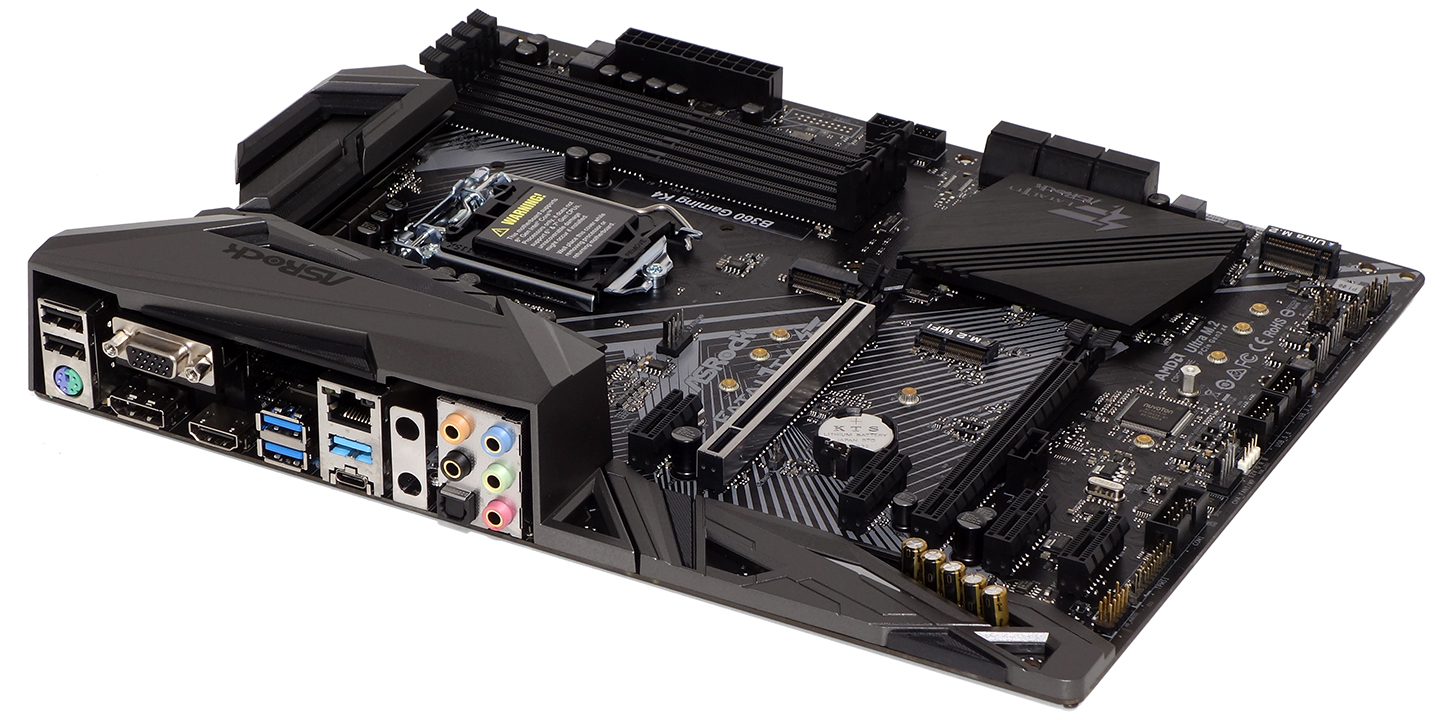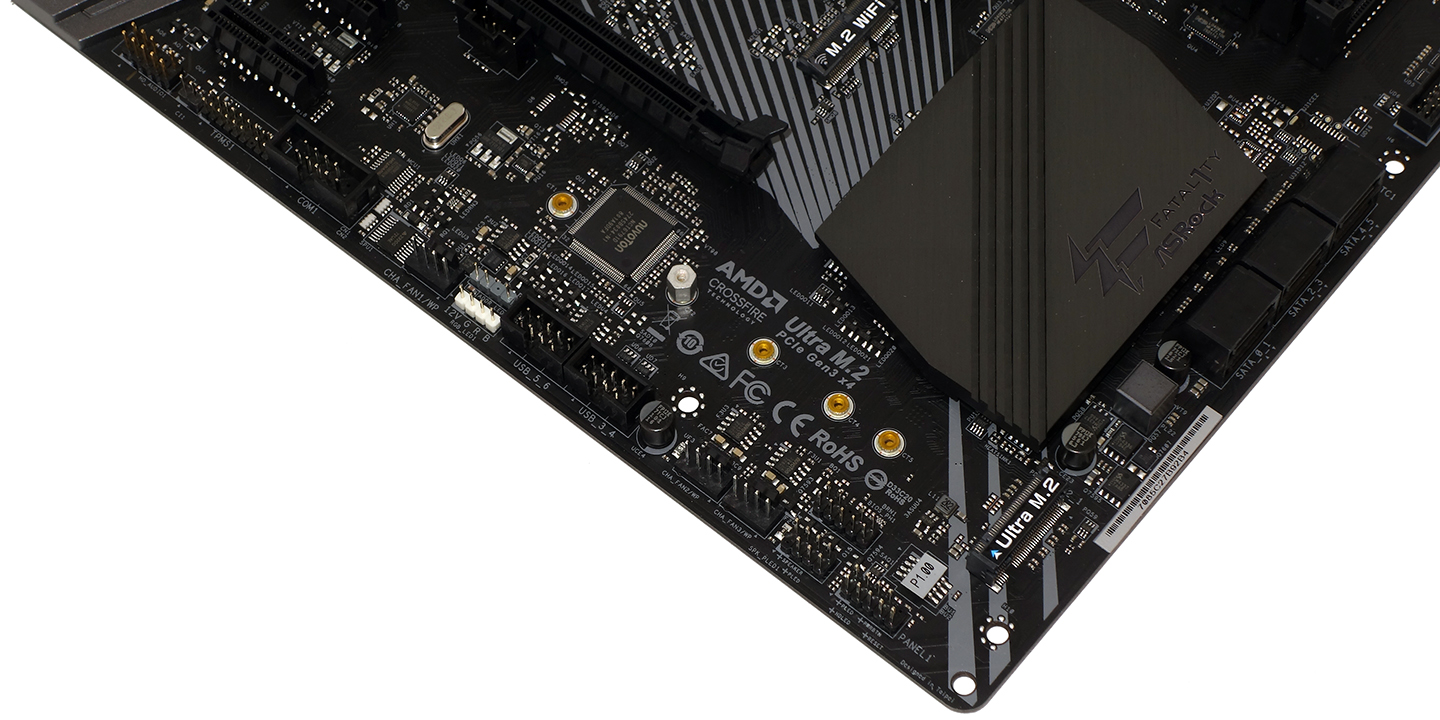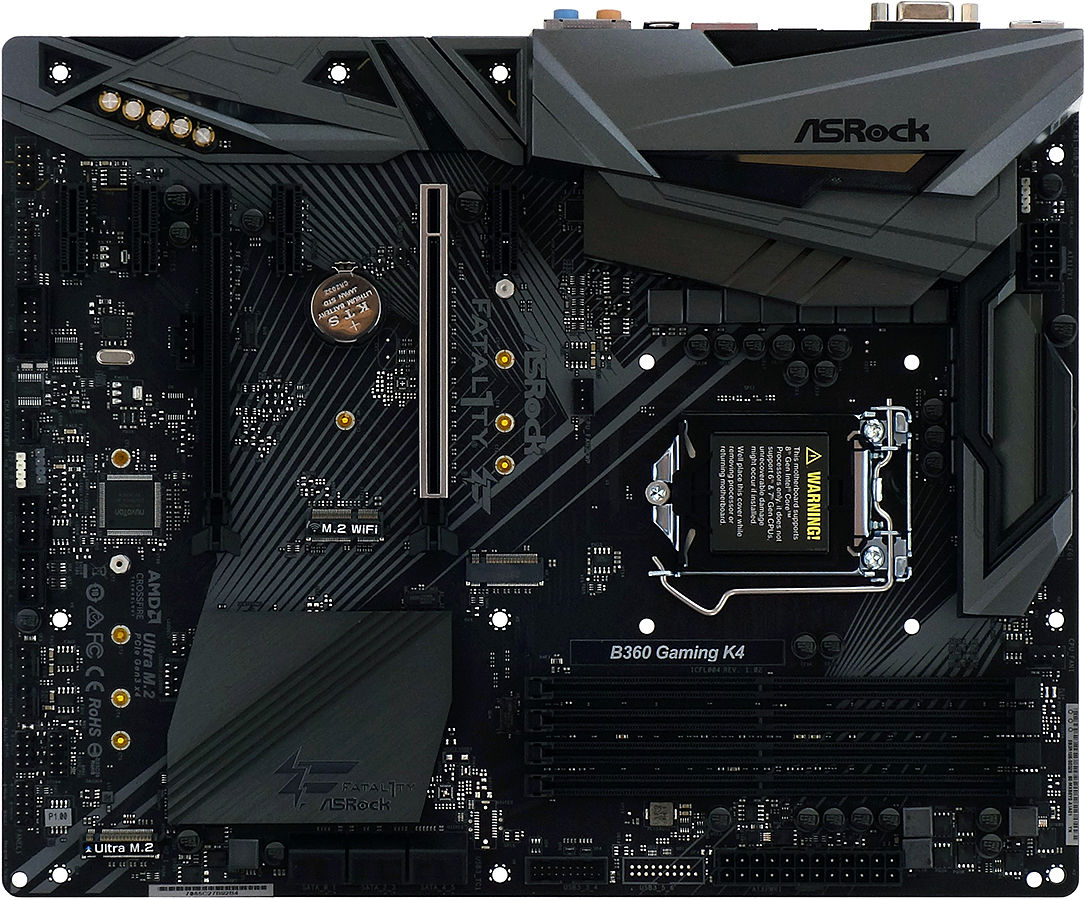Tom's Hardware Verdict
Potential B360 Gaming K4 buyers who can scrape up an extra $5 will find equal or better value than this board in ASRock’s Fatal1ty H370 Performance, which uses the same PCB but a higher-end chipset.
Pros
- +
Slightly cheaper than ASRock’s H370 version
- +
Quality audio components
- +
Comprehensive connectors for RGB light strips
Cons
- -
Fewer features than ASRock H370 model, but only $5 cheaper
- -
Integrated Wi-Fi antenna bracket, but no antenna or Wi-Fi module included
Why you can trust Tom's Hardware
Features & Layout
How far can you go when cutting costs, while still appealing to budget-conscious enthusiasts? Intel's B360 chipset, a couple steps down from the Z370 flagship, walks that line well in terms of features. It nixes overclocking and multi-card graphics support, but adds integrated USB 3.1 Gen2 abilities while--in theory at least--making for more-affordable motherboards.
The ASRock Fatal1ty B360 Gaming K4 we're looking at here, however, falls flat primarily because of pricing. For just $5 more, the ASRock Fatal1ty H370 Performance offers better connectivity and more PCIe bandwidth for graphics and speedy NVMe storage. And for this B360 board's $115 asking price, you can even find a few alternatives with the flagship Z370 chipset, giving you all the features that B360 takes away.
Specifications
| Socket | LGA 1151 |
| Chipset | Intel B360 |
| Form Factor | ATX |
| Voltage Regulator | 10 Phases |
| Video Ports | VGA, DisplayPort 1.2, HDMI 1.4 |
| USB Ports | 10Gbps: (1) Type-C, (1) Type A 5Gb/s: (2) Type A; (2) USB 2.0 |
| Network Jacks | Gigabit Ethernet |
| Audio Jacks | (5) Analog, (1) Digital Out |
| Legacy Ports/Jacks | (1) PS/2 |
| Other Ports/Jack | ✗ |
| PCIe x16 | (2) v3.0 (x16/x4*) (*Shared with PCIe 5, 6) |
| PCIe x8 | ✗ |
| PCIe x4 | ✗ |
| PCIe x1 | (4) v3.0 (Shares lanes with four-lane x16, M.2 Key-E) |
| CrossFire/SLI | 2x / ✗ |
| DIMM slots | (4) DDR4 |
| M.2 slots | (2) PCIe 3.0 x4^ / SATA*, (1) Key-E/CNVi (Consumes *SATA ports 1, 2; ^SATA port 0) |
| U.2 Ports | ✗ |
| SATA Ports | (6) 6Gb/s (Port 0-2 shared w/M.2) |
| USB Headers | (1) v3.0, (2) v2.0 |
| Fan Headers | (5) 4-Pin |
| Legacy Interfaces | Serial COM Port |
| Other Interfaces | FP-Audio, TPM, (2) RGB LED, D-LED, TB-Header |
| Diagnostics Panel | ✗ |
| Internal Button/Switch | ✗ / ✗ |
| SATA Controllers | Integrated |
| Ethernet Controllers | WGI219V PHY |
| Wi-Fi / Bluetooth | ✗ / ✗ |
| USB Controllers | Integrated |
| HD Audio Codec | ALC1220 |
| Warranty | ✗ |
The B360 Gaming K4 uses the same circuit board as the company's H370 Performance motherboard. Shared features start with the I/O panel’s two USB 2.0 and single PS/2 ports, three graphics outputs (VGA, DisplayPort and HMDI) for the CPU’s integrated GPU, two USB 3.1 Gen1 (5Gb/s) ports, Type A and Type-C USB 3.1 Gen2 ports (10Gb/s), a network port wired to Intel’s i219 Gigabit Ethernet hardware, five analog audio jacks fed by Realtek’s ALC1220 codec and a digital optical audio output.
Panning out we see an M.2 storage slot behind the top PCIe x1 slot, an M.2 Key-E slot (typically used for Wi-Fi/Bluetooth) behind the second PCIe x1 slot, and another storage slot near the front edge of the board that points towards the bottom two PCIe x1 slots. Sharing starts here, as the second PCIe x1 slot steals a lane from the Key-E slot, which disables its PCIe mode without impacting CNVi availability. The bottom two x1 slots steal lanes from the four-pathway slot above them, kicking it down to x2 mode. The lower M.2 storage slot has only two lanes to start, and steals one of its HSIO (Intel’s flexible High-Speed I/O) pathways from a SATA port, disabling that port while leaving the other five enabled.
The shared circuit board answers any HSIO resource exclusions not fully addressed in our H370 Performance review, since the only things we see missing from the B360 Gaming K4 are two of the second M.2 slot’s PCIe pathways and the second USB 3.0 front-panel header. Missing features that we can’t see so easily are attributed to the change in chipset, as the B360 loses RAID mode, and the second M.2 slot isn't addressed by Intel RST.
Starting from the top and center of the picture above and going counterclockwise, there's a 5-pin header for addressing a four-lane Thunderbolt add-in card (not included), one of the four PCIe x1 slots, which is open-ended to receive longer (x4, etc) cards, the front-panel HD-Audio cable header, a TPM header, a legacy Serial Communications port, a 4-pin fan header, Addressable and standard RGB light strip headers, two dual-port USB 2.0 headers, two more 4-pin fan headers, a PC (Beep Code) speaker and 3-pin Power-LED header, a standard Intel power/reset/activity LED header.
Moving up the front edge are the second M.2 storage connector, six SATA ports, and the corner of the board’s dual-port SATA 3.0 header. Four of the motherboard’s five fan headers are switchable between pulse width modulation and voltage-based RPM control, and the same four feature 2.0 amp capacity (boosted from 1A on the PWM-only CPU fan header).
Get Tom's Hardware's best news and in-depth reviews, straight to your inbox.
The B360 Gaming K4 has only two SATA ports, which makes sense in the era of M.2 SSDs, but might not work for some builders who are attempting to transfer multiple drives from an older system. An I/O shield, driver disc and printed documentation make up the board's modest in-box accessories.
MORE: Best Motherboards
MORE: How To Choose A Motherboard
MORE: All Motherboard Content
-
Co BIY With only $5 difference between them it seems that it's a waste for Intel to have multiple chipsets so close in features.Reply






